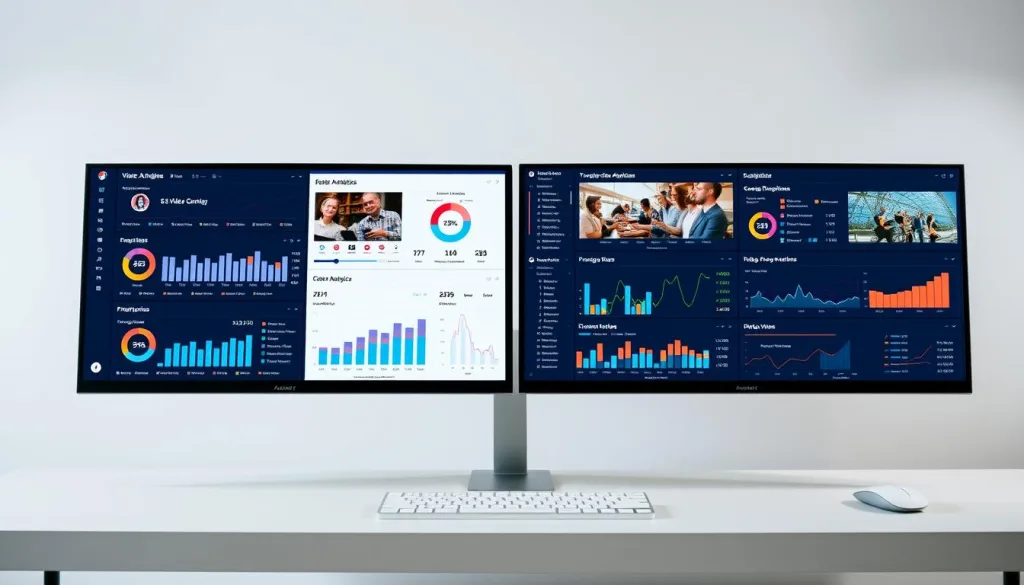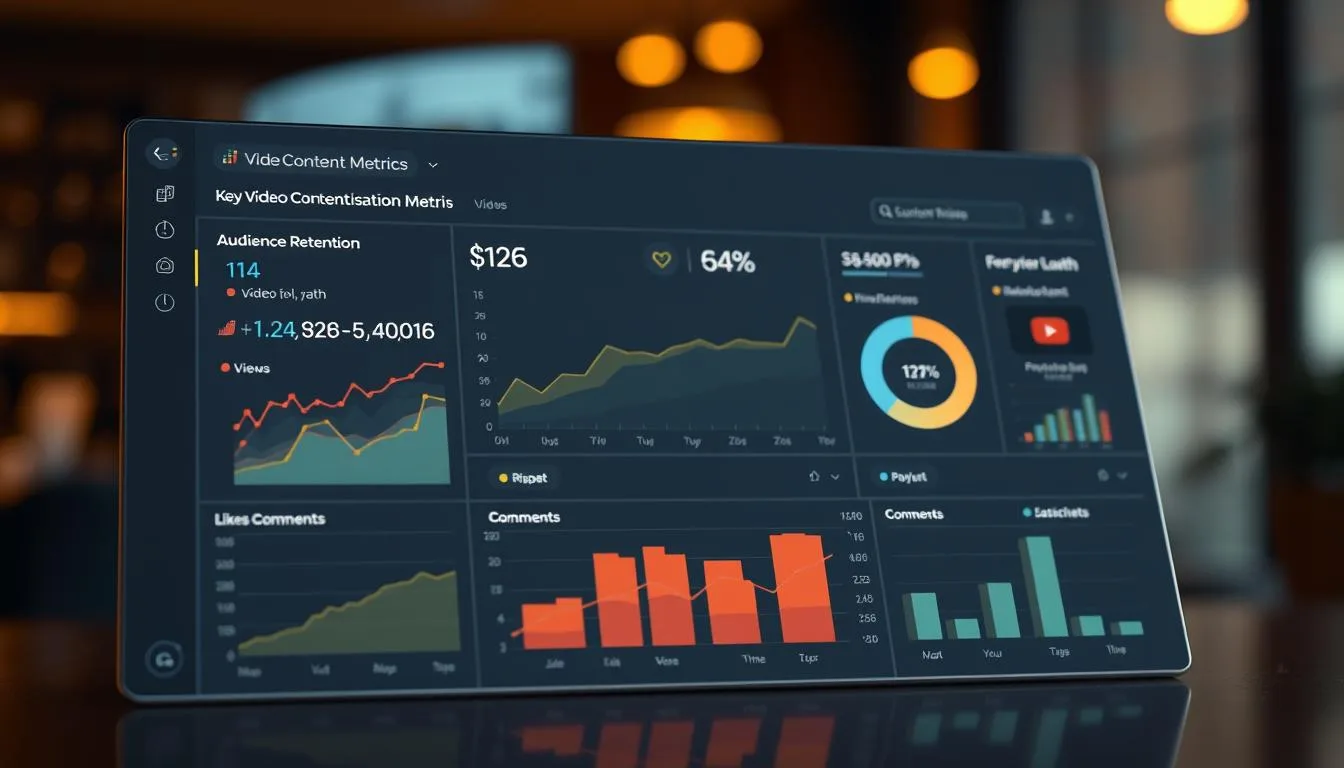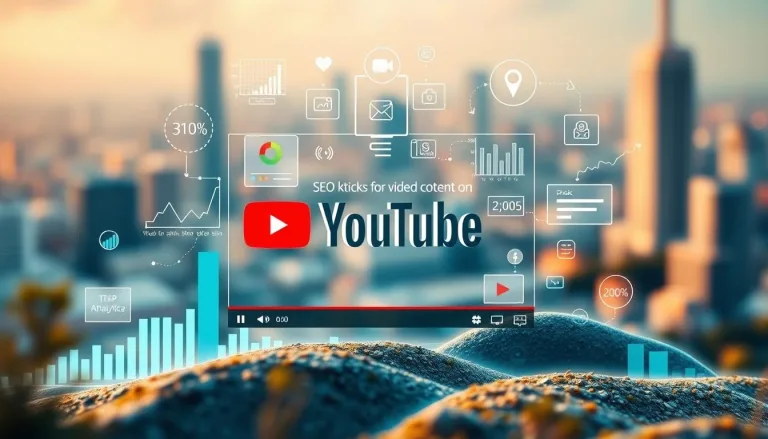Key Metrics Every Video Creator Should Track
In today’s digital world, video content is a key marketing tool for businesses and creators. It turns data into useful insights that help content succeed.
Peter Drucker once said, “What gets measured gets managed.” This is very true for video marketing. By tracking the right metrics, creators can see how viewers act, improve their content, and reach their goals.
Good video creators see metrics as more than just numbers. They show how well content connects with viewers and how it can grow. By looking at data, creators can make their content better and connect more with their audience.
The digital world rewards creators who use data to guide their work. Video metrics give a full picture of how content performs. They show what viewers like, how they watch, and the impact of the content.
Whether you’re experienced or new, knowing video metrics is key for a strong video marketing plan. The next parts will cover the most important metrics for creators to track. This will help them make their content better and achieve real success.
Understanding Video Analytics Fundamentals
Video production and YouTube video creation rely heavily on data. Knowing the metrics behind your content helps you make better decisions. Analytics give you key insights into how viewers interact with your videos.
Data reveals a lot about audience engagement. It helps creators fine-tune their approach to keep viewers interested. Successful creators use these insights to make their content more engaging.
What Are Video Metrics?
Video metrics measure how well your video performs. They fall into three main categories:
- Quantitative Metrics: Numbers like view count, watch time, and subscriber growth
- Qualitative Metrics: Feedback, comment sentiment, and audience reactions
- Conversion Metrics: Click-through rates, lead generation, and sales attribution
Why Tracking Metrics Matters
Tracking video metrics is key to understanding your audience. It helps you optimize your content and improve video quality. By analyzing data, you can:
- Find out what content types engage your audience
- Learn about your viewers’ demographics
- Improve your YouTube video creation
- Keep your audience watching longer
Types of Video Performance Data
Each platform offers its own analytics tools. YouTube gives you detailed insights into viewer behavior. Creators should use these metrics to create more targeted and effective content.
Video Content Creation: Essential Performance Indicators
Creating great social media video content means knowing the key performance indicators. Creators need to watch specific metrics to see how well their content works. This helps them improve how they connect with their audience.
The most important performance indicators for video content are:
- View Count: Shows how many times a video has been watched
- Play Rate: Tells how many visitors click play after seeing the video thumbnail
- Watch Time: Shows how long viewers spend watching the video
- Completion Rate: Tells how many viewers watch the whole video
Looking at these metrics gives creators valuable insights. View count shows how many people first see the video. Play rate shows if the thumbnail and title grab viewers’ attention.
| Metric | Purpose | Key Insight |
|---|---|---|
| View Count | Measure initial reach | Video’s possible audience size |
| Play Rate | Assess thumbnail effectiveness | Viewer interest and content appeal |
| Watch Time | Evaluate content engagement | Viewer retention and interest level |
| Completion Rate | Measure content quality | Video’s ability to keep viewer attention |
Video creators can use these indicators to make their social media video content better. They can make videos that are more engaging and impactful. This way, they can better connect with their audience.
Engagement and Viewer Behavior Metrics
Understanding viewer engagement is key for great video editing services and professional video creation. These metrics show how people interact with content. They give creators valuable insights to improve their strategies.
Watch Time and Audience Retention
Watch time shows how long viewers watch a video. Professional video creators aim to keep audiences hooked from start to end. High retention rates mean the content hits the mark with viewers.
- Measure total watch time across different video segments
- Analyze drop-off points in video content
- Identify most compelling content sections
Social Sharing and Comments
Social interaction metrics show a video’s reach beyond view counts. Video editing services use these insights to gauge audience connection and content success.
| Metric | Significance | Interpretation |
|---|---|---|
| Shares | Content Virality | Indicates audience enthusiasm |
| Comments | Audience Engagement | Reflects content’s emotional impact |
Click-through Rates
Click-through rates show how well videos prompt viewers to act. Successful video editing services create content that entertains and motivates viewers to take action.
- Track links clicked within or after video
- Analyze call-to-action effectiveness
- Optimize content for increased interaction
Measuring Audience Growth and Reach

A strong video marketing plan needs to track audience growth carefully. Content creation agencies know that just looking at view counts isn’t enough. They look at detailed data to see how much the audience is growing and how well the content is doing.
Important metrics for tracking audience growth include:
- Subscriber growth rate
- Share of voice in your industry
- Total video impressions
- Audience demographic expansion
Digital marketers know that quantitative insights are key to understanding how well content is doing. These metrics help creators see if their strategies are working and where they can get better.
| Metric | Measurement Significance | Impact Level |
|---|---|---|
| Subscriber Growth | Number of new channel followers | High |
| Share of Voice | Brand visibility compared to competitors | Medium |
| Impressions | Total possible audience reach | High |
By tracking these metrics, creators can make video marketing plans that grow their audience and make their brand more visible.
Conversion and ROI Tracking
Video production is more than just making cool videos. It’s about getting real business results. Knowing how videos help with leads, sales, and ROI is key for creators and marketers.
Good video marketing means looking at real numbers. It’s not just about how many people watch. We need to see how it really works.
Lead Generation Metrics
Great video content turns viewers into customers. Important metrics include:
- Number of qualified leads generated
- Email sign-ups from video landing pages
- Contact form submissions after video viewing
- Webinar or demo request rates
Sales Attribution
Seeing how videos affect sales is vital. Sales attribution shows which videos bring in money and help customers.
- Direct sales generated from video links
- Conversion rates from video-driven traffic
- Customer acquisition cost through video channels
Return on Investment Calculation
ROI makes video production a smart business move. It’s about comparing costs to what you make.
ROI = (Revenue Generated – Production Cost) / Production Cost × 100%
For example, a $5,000 video campaign might make $20,000. That’s a 300% ROI, showing video’s big impact.
Platform-Specific Analytics

Understanding social media video content is complex. Each platform has its own way of measuring video success. Creators need to know how to make videos for YouTube and social media.
Platforms use different metrics to see how well videos do. Here are some important differences:
- YouTube counts a view after 30 seconds of watch time
- Facebook considers a view at 3 seconds of playback
- Instagram tracks views from the first second
- TikTok measures engagement through scroll and replay rates
These differences change how creators see their video success. A view on one platform might not mean the same on another. Creators must adjust their YouTube video plans for each platform.
Advanced creators use these analytics to improve their videos. By knowing these metrics, they can:
- Tailor content length to platform expectations
- Adjust storytelling techniques
- Optimize thumbnail and preview strategies
- Target specific audience segments
Getting good at these analytics helps creators make better videos. They can then engage their audience more effectively.
Conclusion
Creating successful videos means knowing and using key performance metrics. Creators who dive into analytics get insights that change their strategy. They track how people engage with their videos and what works best.
By using a wide range of tracking tools, creators find out what they do well and what they can improve. Tools like native analytics and specialized software give them the data they need. This helps them make choices based on what their audience likes.
The process of making engaging videos never stops. Creators who keep track of their metrics improve over time. They make videos that keep viewers interested and create digital experiences that matter.
Getting good at video metrics is all about connecting with your audience. Creators who spend time on data analysis find new ways to grow and engage their audience. This is key in the fast-changing world of digital media.







